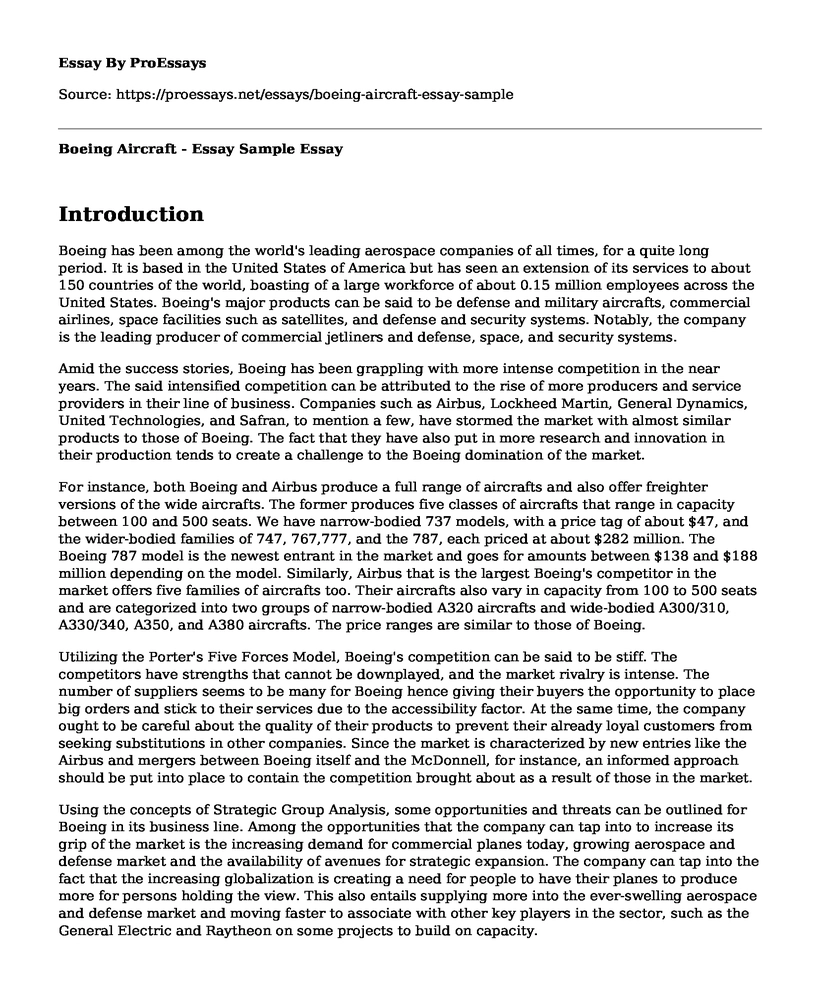Introduction
Boeing has been among the world's leading aerospace companies of all times, for a quite long period. It is based in the United States of America but has seen an extension of its services to about 150 countries of the world, boasting of a large workforce of about 0.15 million employees across the United States. Boeing's major products can be said to be defense and military aircrafts, commercial airlines, space facilities such as satellites, and defense and security systems. Notably, the company is the leading producer of commercial jetliners and defense, space, and security systems.
Amid the success stories, Boeing has been grappling with more intense competition in the near years. The said intensified competition can be attributed to the rise of more producers and service providers in their line of business. Companies such as Airbus, Lockheed Martin, General Dynamics, United Technologies, and Safran, to mention a few, have stormed the market with almost similar products to those of Boeing. The fact that they have also put in more research and innovation in their production tends to create a challenge to the Boeing domination of the market.
For instance, both Boeing and Airbus produce a full range of aircrafts and also offer freighter versions of the wide aircrafts. The former produces five classes of aircrafts that range in capacity between 100 and 500 seats. We have narrow-bodied 737 models, with a price tag of about $47, and the wider-bodied families of 747, 767,777, and the 787, each priced at about $282 million. The Boeing 787 model is the newest entrant in the market and goes for amounts between $138 and $188 million depending on the model. Similarly, Airbus that is the largest Boeing's competitor in the market offers five families of aircrafts too. Their aircrafts also vary in capacity from 100 to 500 seats and are categorized into two groups of narrow-bodied A320 aircrafts and wide-bodied A300/310, A330/340, A350, and A380 aircrafts. The price ranges are similar to those of Boeing.
Utilizing the Porter's Five Forces Model, Boeing's competition can be said to be stiff. The competitors have strengths that cannot be downplayed, and the market rivalry is intense. The number of suppliers seems to be many for Boeing hence giving their buyers the opportunity to place big orders and stick to their services due to the accessibility factor. At the same time, the company ought to be careful about the quality of their products to prevent their already loyal customers from seeking substitutions in other companies. Since the market is characterized by new entries like the Airbus and mergers between Boeing itself and the McDonnell, for instance, an informed approach should be put into place to contain the competition brought about as a result of those in the market.
Using the concepts of Strategic Group Analysis, some opportunities and threats can be outlined for Boeing in its business line. Among the opportunities that the company can tap into to increase its grip of the market is the increasing demand for commercial planes today, growing aerospace and defense market and the availability of avenues for strategic expansion. The company can tap into the fact that the increasing globalization is creating a need for people to have their planes to produce more for persons holding the view. This also entails supplying more into the ever-swelling aerospace and defense market and moving faster to associate with other key players in the sector, such as the General Electric and Raytheon on some projects to build on capacity.
On the other hand, a glaring threat to Boeing's operation is the fixed price contracts. This has led to improved efficiencies and cost reductions for the company, but their continued use can lead to lower margins hence the poor financial status of the company.
Conclusion
In conclusion, if Boeing manages the stiff competition it faces and the threats by investing heavily in innovations and research to capture its opportunities, it will continue leading in the aerospace sector.
Cite this page
Boeing Aircraft - Essay Sample. (2022, Dec 14). Retrieved from https://proessays.net/essays/boeing-aircraft-essay-sample
If you are the original author of this essay and no longer wish to have it published on the ProEssays website, please click below to request its removal:
- Marketing Report Sample on Nike Company
- Evaluation Essay on Walmart: External and Internal Environments
- Paper Example on Wright Brothers Challenges in Developing the World's First Aircraft
- Essay on Maximizing Benefits of Corporate Social Responsibility (CSR): Microsoft.inc Case Study
- Essay on Amazon Must Re-Evaluate Overlapping Privacy Scandal: New Alexa-Enabled Wearable Microphones
- Paper Example on Walmart's Challenges to Operational Sustainability
- Coca-Cola's Impact on the Soft Drink Industry: Brand Equity & Innovation - Essay Sample







